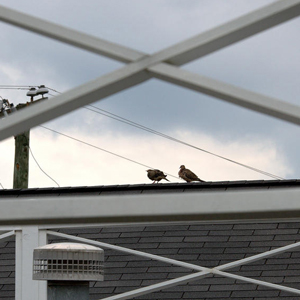Look Out for Bird or Bat Droppings When Renovating
By Chris Williams on January 21, 2014.
 Most people are completely unaware of a hazard that they face when renovating their home or property. That hazard is bird or bat droppings. We’re not talking about those few white splats on your sidewalk left by sparrows sitting on your roof gutters. We’re talking about extensive accumulations of droppings from roosting or nesting sites that have been in use for years. Bird and bat droppings are the source for more than one fungal disease that affects humans (see Bird Droppings Can Be Hazardous to Your Health).
Most people are completely unaware of a hazard that they face when renovating their home or property. That hazard is bird or bat droppings. We’re not talking about those few white splats on your sidewalk left by sparrows sitting on your roof gutters. We’re talking about extensive accumulations of droppings from roosting or nesting sites that have been in use for years. Bird and bat droppings are the source for more than one fungal disease that affects humans (see Bird Droppings Can Be Hazardous to Your Health).
Histoplasmosis is the fungal disease of primary concern. People can get histoplasmosis when they inhale microscopic fungal spores associated with bird or bat droppings. The fungus grows in soil that is nitrogen-enriched from the droppings. Human exposure usually occurs when the droppings are disturbed and become airborne during cleanup. Most people who inhale the spores do not get sick. However, some people develop a lung infection with flu-like symptoms initially, that can develop into a serious chronic disease resembling tuberculosis.
Typical situations resulting in accumulations of droppings occur when large numbers of bats have been roosting in an attic for an extended time, or when pigeons or other birds are roosting on building rooftops, on ledges, under bridges, or roosting anywhere in large numbers for a long time. Droppings usually must be at least three years old before Histoplasmosis capsulatum spores develop.
Certain jobs or professions put individuals at higher risk for exposure to histoplasmosis: bridge painter, chimney cleaner, renovator of historic buildings, HVAC installer, roofer, and pest control technician are just a few. The Centers for Disease Control (CDC) recently reported on 14 people in Quebec who came down with histoplasmosis symptoms after demolition work on a century-old brick house. The affected ranged from masons, to debris sorters, to the family who lived on the ground floor. Workers had noticed a large quantity of dried droppings behind the bricks and reported inhaling considerable demolition dust while on the job.
How Could Histoplasmosis Affect Me?
For homeowners, the most likely exposure is working in an infected attic or cleaning out an old barn or shed that has been home to birds or bats. Anyone who is demolishing, restoring, or cleaning out an old home or outbuilding that has been vacant for some time should think about whether or not birds or bats have been occupying that space. If so, you may need to take precautions to protect yourself from histoplasmosis.
The Centers for Disease Control recommends that appropriate exposure precautions be taken whenever people disturb contaminated soil, bat droppings (guano), or bird manure. Appropriate precautions include wetting the droppings with a water spray to keep dust from becoming airborne, and use of gloves and a disposal Tyvek® suit. A NIOSH-approved respirator (not a paper dust mask) is used to prevent inhalation of fungal spores. There are guidelines for safe disposal of the removed droppings, as well. For detailed information on histoplasmosis and its prevention, visit www.cdc.gov/fungal/histoplasmosis.